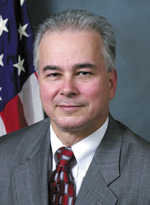Food Safety Magazine: During your tenure as director of CFSAN's Food Safety and Security Staff, FDA has developed many new initiatives and programs to ensure a safe and wholesome food supply. Would you describe some of the most significant of these and what impact they've had on stakeholders?
 Robert Brackett: Following the event of Sept. 11, 2001, one of the most significant events has been the President's signing of the Public Health Security and Bioterrorism Preparedness and Response Act (the Bioterrorism Act) in June 2002. This regulatory act alone has significantly helped shape new food security responsibilities for CFSAN, and we have been busily preparing to finalize and implement four new regulations stemming from this act by the end of the year.
Robert Brackett: Following the event of Sept. 11, 2001, one of the most significant events has been the President's signing of the Public Health Security and Bioterrorism Preparedness and Response Act (the Bioterrorism Act) in June 2002. This regulatory act alone has significantly helped shape new food security responsibilities for CFSAN, and we have been busily preparing to finalize and implement four new regulations stemming from this act by the end of the year.
To date, we have published proposed regulations that include "Registration of Food Facilities," "Prior Notice of Imported Food Shipments," "Establish-ment and Maintenance of Records," and "Administrative Detention," each of which has had open comment periods. These new regulations will enhance food safety and security by helping to identify and to deter potential threats to the U.S. food supply. Virtually all of our stakeholders, including industry and importers, will be affected by the requirements of these new regulations, and we are pleased to have had substantial input and comments from the food industry throughout the development of these regulations.
In an effort to make it easier for companies to comply with the prior notice requirements of the Bioterrorism Act, FDA and the U.S. Bureau of Customs and Border Protection recently announced that we would allow importers to provide required information on food imports to both agencies using an integrated process. Rather than file information with both agencies, in most cases, importers will be able to provide the required information to FDA via U.S. Customs' existing system, with which they already have familiarity.
Although recent attention has focused on FDA's role in food security, the importance of proper diet and nutrition is growing increasingly evident. A prime example of this is the growing obesity epidemic that our nation faces. By expanding our traditional food safety education and outreach efforts to focus on issues relating to consumer health and nutrition, we hope to provide consumers with information that will allow them to eat healthier.
FDA's most recent and prominent effort affecting consumers was launched in December 2002 with the announcement of the establishment of the Consumer Health Information for Better Nutrition Initiative. This initiative was designed to provide consumers with more and better information about the health benefits of foods, thus enabling them to make healthier dietary choices. In order to achieve this, FDA created a task force to develop a framework to help consumers obtain accurate, up-to-date, science-based information about conventional foods and dietary supplements.
As part of their effort, they held meetings with stakeholders representing the food and dietary supplement industries, consumer groups, health professionals and members of academia, as well as solicited comments through public docket. The task force recently issued a report that included recommendations on how petitions for qualified health claims will be filed and evaluated. To ensure that adequate resources are available for this effort, CFSAN has recently reassigned staff to its Office of Nutritional Products, Labeling, and Dietary Supplements.
Another key initiative has been the expansion of our outreach to Spanish-speaking U.S. residents. Spanish is the second most frequently spoken language in the U.S., and for many residents, it is either their primary tongue or the best understood language. By providing food safety and nutrition messages in Spanish we hope to bolster the effectiveness of our public health messages. In addition to translating numerous CFSAN documents and brochures into Spanish, we have regularly translated much of our outreach (such as videostreams) on various topics, including the proposed regulations on the Bioterrorism Act.
Food Safety Magazine: Recently, the term "Security" was added to your office's name. Why this was done?
Brackett: We are now called the Food Safety and Security Staff (FSSS), of which I am the director. This extension of our name reflects an aspect of our work that has been expanding since September 2001. Our former name was the Food Safety Staff. This change also emphasizes the close linkage between food safety and food security: A more secure food supply leads to a safer food supply. We are increasing the food security-related component of our work while maintaining our food safety foundation.
The expanded focus of FSSS influences the landscape of our internal and external role. While our emphasis has traditionally been on food safety, the current attention and legislation on food security prompts us to support new projects, to enhance new communication networks and to build additional collaborations to improve food security. We have enlisted expertise from the Institute of Food Technologists (IFT) to help identify ways to improve food security. Through a new task order under an existing contract, IFT will assist us in prioritizing potential counterterrorism (CT) threats and will review potential preventive solutions for industry. Moreover, we are strengthening collaborative ties with other regulatory agencies, law enforcement and intelligence communities to better position us to meet food security challenges.
The renaming of our staff also supports the centralization of CT efforts within CFSAN. As Director of FSSS, I serve as the new CT focal point for CFSAN's Center Director, Joseph Levitt. While many people in CFSAN are involved in CT activities, there was a need for a focal point for rapid response and coordination within CFSAN, with others in FDA and the Department of Health and Human Services, with other federal and state agencies and with industry. The Food Safety and Security Staff supports outreach and risk communication efforts to inform consumers, industry and all stakeholders about emerging events that impact food security.
Food Safety Magazine: What kinds of food safety initiatives are currently priorities for CFSAN, and why?
Brackett: Two of CFSAN's current key initiatives are improving food security and providing better consumer food information on topics such as health claims for foods and dietary supplements. Our current work plan, which is put forth in CFSAN's Fiscal Year (FY) 2003 Program Priorities document, focuses heavily on ensuring the security of our country's food supply as a primary goal. With the enactment of the Bioterrorism Act, much of our effort during the current year focuses on issuing the necessary regulations to implement this statute. While we continue to enhance our level of emergency preparedness--particularly our laboratory preparedness--FDA efforts across the country emphasize our increased focus on import inspections, high-risk food inspections and laboratory sampling.
Our FY 2003 work plan also places a high priority revitalization on our applied nutrition program. To bolster the applied nutrition position of CFSAN's activities, a new position, Senior Advisor for Applied Nutrition, has been added to the Center Director's management team. This is being done to better coordinate and respond to the growing issues surrounding nutrition, obesity and dietary supplements. The initial duties of this position include establishing processes for the review of qualified health claims for conventional foods. Dr. Alan Rulis, currently Director of the Office of Food Additive Safety, has been appointed to this position on an interim basis.
We also are highly involved in ongoing food hazard-specific risk assessments to protect our food supply. Risk assessment is an essential tool for evaluating potential risk from a given food pathogen or food toxicant. Using this careful analysis, we can develop programs to minimize risk from potential food hazards. Our Egg Safety Program is an example of effective risk assessment application. All shell egg cartons now require safe handling instructions on refrigerating and cooking eggs properly. This fiscal year, we hope to issue a new proposed egg safety rule to further reduce human illnesses from Salmonella Enteritidis.
In addition to these priorities, the Program Priorities document identifies eight other program and cross-cutting priority areas: (1) cosmetics; (2) enhancing the science base; (3) international activities; (4) food biotechnology; (5) enhancing internal processes; (6) focused economic-based regulations; (7) equal employment opportunity/diversity initiatives; and (8) management initiatives.
Food Safety Magazine: What CFSAN outreach programs are available to industry, the research community or consumers? How do these further food safety goals?
Brackett: FDA's programs often include outreach to industry, academia or consumer stakeholders, and, in some cases, to all of these stakeholder groups. FDA is committed to using a science-based decision-making process as it works to ensure safe food for consumers. An important part of this decision-making process is to gather information from stakeholders. Whether we are developing new regulations, determining best practices or studying new evidence, we regularly request and receive relevant information from outside parties.
Recent examples of outreach are the satellite downlink public meetings that were held in January and May of this year, to discuss the proposed regulations relating to the Bioterrorism Act. The January meeting focused on the proposals for Registration of Food Facilities and Prior Notice of Imported Food Shipments. The May meeting covered the proposals for Establishment and Maintenance of Records among food firms and the Administrative Detention of foods that may pose a risk to public health. These meetings addressed industry questions about, and reminded participants and viewers to submit comments on the proposals. Such comments, especially from those stakeholders most affected by the new regulations, are critical in helping us develop feasible and effective regulations. While the comment period for these regulations is now closed, this outreach helps FDA keep communication channels open with affected groups.
As part of a Hispanic initiative to reduce and eliminate disparities in health status among this population, the Food Safety Staff awarded a contract to Radio Unica, the largest Hispanic radio network in the U.S., to effectively communicate information about food safety issues, including steps that can be taken to reduce the risk of foodborne illness. This last year, we participated in Radio Unica's Hispanic Health Fair campaign to educate Hispanic consumers about safe food handling by using food safety educational materials, many of which were in Spanish. The health fairs provide a unique and highly targeted medium to arm the Hispanic consumer with life-saving information and lifelong habits that they can pass on. The last set of health fairs reached more than 18,000 people.
Targeted outreach to other consumer groups has also been a priority. In conjunction with the National Science Teachers Association, we developed an educational package for middle and high school teachers to take food safety information into classrooms around the country, thus reaching hundreds of thousands of U.S. students. Moreover, we have disseminated information on food safety matters, such as Listeria monocytogenes, specific to pregnant women and to other at-risk groups, including older U.S. residents. Our Food Safety for Seniors brochure (in both Spanish and English), as well as the Food Safety for Seniors video, have been disseminated through mailings and trade meetings. CFSAN also has focused consumer outreach efforts on the risks associated with specific food safety hazards, such as consuming raw oysters containing Vibrio vulnificus.
Additionally, we conduct various forms of outreach to and with academic and professional groups. The Joint Institute for Food Safety and Applied Nutrition (JIFSAN) was established between FDA and the University of Maryland in April 1996. The institute is a jointly administered, multidisciplinary research and education program and includes research components from the University of Maryland, CFSAN, and FDA's Center for Veterinary Medicine (CVM). JIFSAN currently is playing an integral role for the international community in acting as repository of growing data about acrylamide in foods. We also provide information on foodborne illnesses to health professionals through a variety of media, including a health professionals link on CFSAN's home page, thus targeting a variety of stakeholders in food safety and public health. In addition, our staff exhibited and distributed food safety information at various professional meetings around the country.
Further, we also conduct various forms of outreach to and with the international community. CFSAN initiated regional outreach meetings on food safety (also known as roadshows) in the fall of 1999 in an effort to update key trading partners on U.S. food safety activities and to provide basic information on our foods program to key trading partners. Six regional meetings have been held around the world. Due to the success of these meetings in communicating the U.S. level of protection to other nations, the food safety roadshow planned for 2003 includes a one-day regional outreach meeting on food safety in September in Buenos Aires, Argentina. U.S. delegates will discuss the U.S. food safety infrastructure, exporting foods to the U.S., and U.S. activities to protect the food supply from terrorist attacks.
Food Safety Magazine: In your view, what are the most important next steps that CFSAN and stakeholders can take to achieve food safety goals?
Brackett: Important next steps would include the development of better mechanisms to communicate sensitive information with industry in order to protect national security interests; the continued use of risk assessment, risk management and risk communication to learn and refine our food safety and security efforts; and working toward improving public health by cooperating with sister agencies to use better surveillance tools and data reporting to further focus and assess the success of our programs.
Our goals are to provide industry with tools to better produce safe and wholesome foods, to apply our expertise and knowledge to solve problems, and to enforce the regulations at our disposal to optimize food safety and security. To achieve this, we use the framework of risk assessment, risk management and risk communication based on knowledge working together to provide the safest and securest food supply. The coordinated efforts of industry, academia and consumers, as well as federal, state and local partners are critical to optimizing U.S. food safety and security. We will proceed by identifying what measures can and should be undertaken to boost food security while providing consumers with information to make healthy and safe food choices.
In Touch with FDA's CFSAN Food Safety and Security Staff




